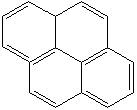PRODUCT IDENTIFICATION

TOXICITY
CLASSIFICATION
Polycyclic aromatic hydrocarbon, Coloring agent, Fluorescent dye, Luminescent agent,
EXTRA NOTES
PHYSICAL AND CHEMICAL PROPERTIES
SOLVENT SOLUBILITY
210 C
EXTERNAL LINKS & GENERAL DESCRIPTION
Drug Information Portal (U.S. National Library of Medicine) - Pyrene
PubChem Compound Summary - Pyrene
IPCS INCHEM - POLICYCLIC AROMATIC HYDROCARBONS
Local:
Due to extended pi-electron cloud overlaps, organometallic molecules or aromatic
oligometers such as anthracene exhibit semiconductor properties. Conductive
polymers have extended delocalized bonds that creates electrical conductivity
when charge carriers generated make positive charges (holes) and negative
charges (electrons) move to opposite electrodes. Doping is the intentional
impurities in a pure semiconductor to generate charge carriers. The
transportation of charges is responsible for fluorescence and electrical energy.
These can form well-ordered thin crystalline films. Organic semiconductors have
some merits of self radiation, flexibility, light weight, easy fabrication, and
low cost. Organic electroluminescence materials have lead to the rapid development of
photovoltaic and display devices such as organic solar cells,
biosensitizers, OLED(Organic Light Emiting Diode),
OTFT(Organic Thin Film Transistor), Wearable Display, and e-Paper. Some examples of organic electroluminescence materials
are:
- Oligomer Electro Luminescence Materials
- 8-hydroxyquinoline aluminum
- Anthracene
- Pentacene
- Penyl substituent cyclopentadiene derivatives
- Phthaloperinone derivatives
- Perylene derivatives
- Rubrene
- Polymer Electro Luminescence Materials
- Polyanilines
- Poly(p-phenylenevinylene)s
- Poly(thiophene)s
- Poly(alkylfluorene)s
- Poly(acetylene)s
|
|
APPEARANCE
90% min
HAZARD OVERVIEW
Toxic by inhalation. May cause skin, eye, and respiratory tract irritation. Toxic to aquatic organisms, may cause long-term adverse effects in the aquatic environment. OSHA Hazards: Carcinogen. Target Organs:Liver, Blood, Kidney
GHS
Danger
PICTOGRAMS


HAZARD STATEMENTS
H330: Fatal if inhaled
H410: Very toxic to aquatic
life with long lasting effects
PRECAUTIONARY STATEMENTS
P273: Avoid release to the environment
P304 + P340:
if inhaled: remove victim to fresh air and keep at rest in
a position comfortable for breathing
P310: immediately
call a poison center or doctor/physician
![]() T
Toxic
T
Toxic![]() N
Dangerous for the environment
N
Dangerous for the environment
RISK PHRASES
23: Toxic by inhalation.
50/53: Very toxic to
aquatic organisms, may cause long-term adverse effects in the aquatic
environment.
SAFETY PHRASES
29: Do not empty into drains.
45: In case of accident
or if you feel unwell, seek medical advice immediately (show the
label where possible).
61: Avoid release to the environment.
Refer to special instructions / safety data sheets.
PRICE INFORMATION